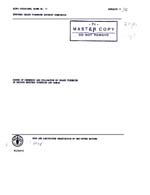
| EIFAC Occasional Paper NO. 11 | EIFAC/OP 11 |
| EUROPEAN INLAND FISHERIES ADVISORY COMMISSION |
 | Survey of ownership and utilization of inland fisheries in various European countries and Canada |
by
E. O'Kelly
principal Officer Emeritus
Fisheries Division, Department of Agriculture and Fisheries, Dublin, Ireland
PREPARATION OF THIS DOCUMENT
This document gives the result of a survey undertaken in the EIFAC region as well as information obtained from Canada on Ownership and utilization of inland fisheries in various European countries and Canada.
| Distribution: | Bibliographic Entry: |
| FAO Department of Fisheries FAO Regional Officers EIFAC mailing list | O'Kelly, E. (1976) EIFAC Occas.Pap., (11):20 p.Survey of ownership and utilization of inland fisheries in various European countries and Canada |
| Lake fisheries. River fisheries. Coastal fisheries. Sport fishing. Permits. Fisheries regulations. Fishery management.Sea laws. Salmon. Trout. Canada. Iceland. Europe. ANE, Baltic. |
EUROPEAN INLAND FISHERIES ADVISORY COMMISSION (EIFAC)
EIFAC documents are issued in four series:
EIFAC Report
Report of each Session in English and French.
EIFAC Technical Paper
Selected scientific and technical papers, including some of those contributed as working documents to Sessions of the Commission or its Sub-Commissions. Published in English and French.
EIFAC Occasional Paper
Papers of general interest to the Commission. Published in the language submitted, either in English or French.
Copies of these documents can be obtained from:
Secretary
European Inland Fisheries Advisory Commission
Department of Fisheries
FAO
Via delle Terme di Caracalla
00100 Rome, Italy
COMMISSION EUROPEENE CONSULTATIVE POUR LES PECHES DANS LES EAUX INTERIEURES (CECPI)
Les documents de la CECPI sont publiés dans quatre séries:
Rapport de la CECPI
Rapport de chaque Session, publié en français et en anglais.
Document Technique de la CECPI
Des documents scientifiques et techniques séléctionnés comprenant certains documents de travail présentés aux Sessions de la Commission ou de ses Sous-Commissions.
Document Occasionnel
Documents d'intérêt général pour la Commission. Publiés dans la langue d'origine, soit
en français, soit en anglais.
Des exemplaires de ces documents peuvent être obtenus en s'adressant au:
Secrétaire
Commission européene consultative pour les pêches dans les eaux intérieures
Département des pêches
FAO
Via delle Terme di Caracalla
00100 Rome, Italie

FOOD AND AGRICULTURE ORGANIZATION OF THE UNITED NATIONS
ROME
Hyperlinks to non-FAO Internet sites do not imply any official endorsement of or responsibility for the opinions, ideas, data or products presented at these locations, or guarantee the validity of the information provided. The sole purpose of links to non-FAO sites is to indicate further information available on related topics.
This electronic document has been scanned using optical character recognition (OCR) software. FAO declines all responsibility for any discrepancies that may exist between the present document and its original printed version.
1. How are fishing rights in freshwater rivers and lakes disposed as to ownership?
2. If private ownership of exclusive fishing rights exists, does this ownership derive from ….
3. If ownership of fishing rights ordinarily derives from riparian ownership, can rights be legally severed from ownership of riparian land?
4. Can exclusive fishing rights be owned collectively and if so, under what circumstances?
5. What arrangements exist for joint management utilization of fisheries in freshwater which are collectively owned, or to which no exclusive title is claimed, e.g., by means of a contract within a cooperative organization?
6. If fishing rights are vested in the state in whole or in part, how is utilization provided for, i.e., by licences, lettings or other concessions? Is preferential treatment given to angling associations, amenity development associations, cooperatives, etc? Do state concessions of fishing rights impose management obligations on the users? Do they in effect delegate management functions entirely to the concessionaires?
7. What provision exists under statute law or by custom concerning public rights of access to state-owned fisheries or to fisheries in which the public are deemed to be entitled to free fishing?
8. What is the legal status of fishing rights in tidal waters: is there any recognized machinery for the acquisition of exclusive rights (whether by individuals or by approved organizations) as against the general public? If so, are there recognized limits within which such acquisition can take place?
9. If cooperative fisheries are carried on in tidal waters, please describe the system as regard (a) the right to fish to the exclusion of the general public and (b) the regulation of catch either in total or as among members of the cooperative.
10. Is the use of commercial methods of fishing subject to regulations by reference to (or in any other way subservient to) the interests of upper water proprietors, e.g., by imposition of extended closed seasons, weekly closed periods for fishing or, in the case of weirs, the maintenance of an unused gap or fishing eye?
11. Apart from conventional conservancy provisions as envisaged in Question 10, to what extent is there provision for exercising quantitative control of fishing by commercial methods?
12. Are there any provisions for levying tax on the use of fisheries which can be made to serve as a means of control?
13. Please describe the methods of fishing employed in coastal and sea fisheries for salmon and trout, indicating any which are usually or exclusively operated under proprietary right.
14. Are commercial methods of fishing subject to (a) state licensing control (b) a fishery rate or other levy imposed to meet conservancy expenses?
15. To what extent does the regulation of angling in tidal waters follow the pattern described for freshwater?
16. Please describe any system prevailing of entitlement to fishing rights in off-shore waters related to ownership of the sea bed or otherwise.
17. Please describe any system practised in your country as regard ownership, reservation of rights or utilization of fisheries which does not come within any of the foregoing suggested classifications.